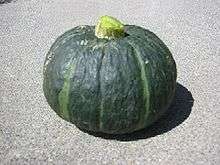Kabocha


Kabocha (/kəˈboʊtʃə/; from Japanese カボチャ, 南瓜) is a type of winter squash, a Japanese variety of the species Cucurbita maxima. It is also called kabocha squash in North America, but another common name is Japanese pumpkin. In Japan, "kabocha" may refer to either this squash or to the Western pumpkin. It has a strong yet sweet flavor and moist, fluffy texture like chestnuts.
Many of the kabocha in the market are kuri kabocha, a type created from seiyo kabocha (buttercup squash). Varieties of kabocha include Ajihei, Ajihei No. 107, Ajihei No. 331, Ajihei No. 335, Cutie, Ebisu, Emiguri, and Miyako.[1]
Description
Kabocha is hard on the outside with knobbly-looking skin. It is shaped like a squat pumpkin and has a dull-finished, deep-green skin with some celadon-to-white stripes and an intense yellow-orange color on the inside. In many respects it is similar to buttercup squash, but without the characteristic protruding "cup" on the blossom (bottom) end. An average kabocha weighs 2-3 pounds, but a large specimen can weigh as much as 8 pounds.[2]
Kabocha has an exceptional sweet flavor, even sweeter than butternut squash. It is similar in texture and flavor to a pumpkin and sweet potato combined. Some kabocha can taste like Russet potatoes. The rind is edible although some cooks may peel it to speed up the cooking process or to suit their personal taste preferences. Kabocha is commonly utilized in side dishes and soups, or as a substitute for potato or other squash varieties. It can be roasted after cutting the squash in half, scooping out the inside rind and seeds, and then cutting the squash into wedges. A little olive oil and seasoning and it can be baked in the oven.
In Japan, kabocha is a common ingredient in vegetable tempura and is also made into soup. Fak thong (Thai: ฟักทอง) is used in traditional Thai desserts and main courses. Kabocha is used in Jamaican chicken foot soup. Danhobak (Korean: 단호박) is commonly used for a traditional Korean porridge called hobakjuk (호박죽), which is mainly eaten during autumn and winter. Hobakjuk in the west is more likely to contain pumpkin than kabocha.
Kabocha is available all year but is best in late summer and early fall. Kabocha is primarily grown in Japan, South Korea, Thailand, California, Florida, Hawaii, Southwestern Colorado, Mexico, Tasmania, Tonga, New Zealand, Chile, Jamaica, and South Africa, but is widely adapted for climates that provide a growing season of 100 days or more. Most of the kabocha grown in California, Colorado, Tonga and New Zealand is actually exported to Japan.
Nutrition
This squash is rich in beta carotene, with iron, vitamin C, potassium, and smaller traces of calcium, folic acid, and minute amounts of B vitamins.[3]
Ripeness
When kabocha is just harvested, it is still growing. Therefore, unlike other vegetables and fruits, freshness is not as important. It should be fully matured first, in order to become flavorful, by first ripening the kabocha in a warm place (77 °F/25 °C) for 13 days to convert some of the starch to sugar. Then the kabocha is transferred to a cool place (50 °F/10 °C) and stored for about a month in order to increase carbohydrate content. In this way the just-harvested, dry, bland-tasting kabocha is transformed into a smooth, sweet kabocha. Fully ripened, succulent kabocha will have reddish-yellow flesh, a hard skin, and a dry, corky stem. It reaches the peak of ripeness about 1.5–3 months after it is harvested.[4]
History
All squashes were domesticated in Mesoamerica. In 1997, new evidence suggested that domestication occurred 8,000 to 10,000 years ago, a few thousand years earlier than previous estimates.[5] That would be 4,000 years earlier than the domestication of maize and beans, the other major food plant groups in Mesoamerica.[6] Archeological and genetic plant research in the 21st century suggests that the peoples of eastern North America independently domesticated squash, sunflower, marshelder, and chenopod.[7]
Portuguese sailors introduced kabocha to Japan in 1541, bringing it with them from Cambodia. The Portuguese name for the squash, Cambodia abóbora (カンボジャ・アボボラ), was shortened by the Japanese to kabocha. Certain regions of Japan use an alternative abbreviated name, bobora, by shortening the second half of the name. Kabocha is written in Kanji as 南瓜 (southern melon), and it is also occasionally referred to as 南京瓜 (Nanking melon).
Gallery
-
Seedling
-
First leaf
-
Branching habit
-
Flower
-
Flower and flower bud
-
Young fruit
-
Whole squashes
-

Section, showing seeds
-
Flower scar
-
Peduncle
-

Dish of roasted kabocha
References
- ↑ "Cultivar differences in New Zealand "Kabocha" (buttercup squash, Cucurbita maxima)". New Zealand Journal of Crop and Horticultural Science. 30 (3): 197–208. 21 June 2002. doi:10.1080/01140671.2002.9514215. Retrieved 27 October 2015.
- ↑ Food Dictionary at Epicurious.com: kabocha squash
- ↑ Kabocha, By Setsuko Yoshizuka, About.com, Wayback Machine
- ↑ "Kabocha (Japanese Pumpkin) A Flavor of the Earth" Gochiso Web Magazine, 2006, p. 8
- ↑ Wade Roush, "Archaeobiology: Squash Seeds Yield New View of Early American Farming", Science Magazine, 9 May 1997:Vol. 276, no.5314, pp. 894-895 DOI: 10.1126/science.276.5314.894
- ↑ Bruce D. Smith, "The Initial Domestication of Cucurbita pepo in the Americas 10,000 Years Ago", Science Magazine, 9 May 1997:Vol. 276 no. 5314 pp. 932-934,DOI: 10.1126/science.276.5314.932
- ↑ Bruce D. Smith, "Eastern North America as an independent center of plant domestication", Proceedings of the National Academy of Sciences (PNAS), Published online before print 7 August 2006, doi: 10.1073/pnas.0604335103 PNAS August 15, 2006; vol. 103, no. 33, pp. 12223-12228
